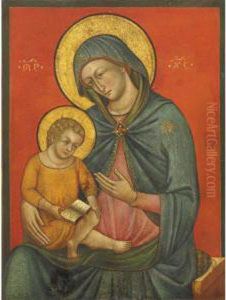Caterino Veneziano Paintings
Caterino Veneziano, also known as Caterino di Maestro Antonio, was a 14th-century Italian painter whose activities spanned from around 1361 to 1382. While specific details about his birth and death are not well-documented, he is known to have been active in Venice, a fact that contributes to his designation as 'Veneziano'. This was a period in which Venetian art was beginning to flourish, yet still heavily influenced by the Byzantine tradition that dominated the region's artistic production during the Middle Ages.
Caterino Veneziano's work is characterized by the Gothic style that was prevalent in Europe at the time, yet it also exhibits the early signs of the coming Renaissance's focus on more naturalistic representations. Unfortunately, much of his work has been lost or remains unidentified, which makes it challenging to fully assess his impact on the development of Venetian art. However, he is known to have contributed significantly to the decoration of the Basilica di San Marco in Venice, one of the most important religious and cultural landmarks in the city.
The lack of comprehensive records about Caterino Veneziano's life and work is not unusual for artists of his time. Many artists from the Middle Ages remain somewhat obscure figures due to the scant documentation and the frequent loss or destruction of their work over the centuries. Despite this, Caterino Veneziano is remembered as a figure who contributed to the early stages of Venice's long and illustrious history as a center of artistic innovation and excellence. His legacy is seen as part of the foundation upon which later Venetian masters, such as Bellini and Titian, would build to establish the Venetian School of the Renaissance, known for its unique use of color, light, and atmosphere.
